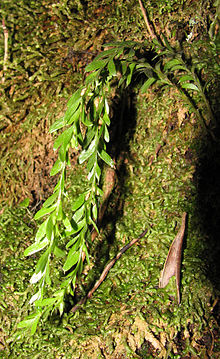Tmesipteris, the hanging fork ferns, is a genus of ferns, one of two genera in the family Psilotaceae, order Psilotales (the other being Psilotum). Tmesipteris is restricted to certain lands in the Southern Pacific, notably Australia, New Zealand and New Caledonia. In New Zealand this hanging epiphyte is common in the warm temperate rain forests of both main islands, where it can normally be found as short spiky dark-green fronds (10–15 cm long), often with lighter bag-like sporangia at the bases of some of its "leaves". The plant possesses no true leaves; what appear to be leaves are flattened stems. The fronds emerge directly from the fibrous root-mats which clad the trunks of mature tree ferns such as Dicksonia and Cyathea. Tmesipteris is from the Greek language, meaning a "cut fern", referring to the truncated leaf tips.[1]
| Tmesipteris | |
|---|---|

| |
| Tmesipteris elongata | |
| Scientific classification | |
| Kingdom: | Plantae |
| Clade: | Tracheophytes |
| Division: | Polypodiophyta |
| Class: | Polypodiopsida |
| Order: | Psilotales |
| Family: | Psilotaceae |
| Genus: | Tmesipteris Bernh. |
| Type species | |
| Tmesipteris tannensis (Sprengel 1800) Bernhardi 1801
| |
| Species | |
|
See text | |
Species
editSpecies include:
- Tmesipteris elongata P.A.Dang - Australia (Victoria and Tasmania) and New Zealand (North Island, South Island, Stewart Island, Chatham Islands)[2][3]
- Tmesipteris gracilis Chinnock 2003
- Tmesipteris horomaka Perrie, Brownsey & Lovis - New Zealand (Banks Peninsula)[4]
- Tmesipteris lanceolata P.A.Dang. - New Caledonia and New Zealand (presumed extinct in Queensland)[2][5]
- Tmesipteris norfolkensis P.S.Green (hanging fork-fern[2])
- Tmesipteris obliqua Chinnock (long fork-fern[2])
- Tmesipteris oblongifolia A.F.Braithw. 1986
- Tmesipteris ovata N.A.Wakef. (oval fork-fern[2])
- Tmesipteris parva N.A.Wakef. (small fork-fern[2])
- Tmesipteris sigmatifolia Chinn. - New Caledonia and New Zealand[5]
- Tmesipteris solomonensis Braithwaite 1973
- Tmesipteris tannensis (Spreng.) Bernh. - New Zealand[4]
- Tmesipteris truncata (R.Br.) Desv. - Australia (New South Wales and Queensland)
- Tmesipteris vanuatensis Braithwaite 1986
- Tmesipteris vieillardii P.A.Dang - New Caledonia[5]
- Tmesipteris zamorae Gruèzo & Amoroso, 2012 - Philippines[6]
Phylogeny
editNitta et al. 2022[7] and Fern Tree of life[8]
| |||||||||||||||||||||||||
References
edit- ^ Les Robinson - Field Guide to the Native Plants of Sydney, ISBN 978-0-7318-1211-0 page 303
- ^ a b c d e f "Tmesipteris". Australian Plant Name Index (APNI), IBIS database. Centre for Plant Biodiversity Research, Australian Government, Canberra. Retrieved 6 April 2011.
- ^ "Tmesipteris elongata". Hebe Society. Retrieved 6 April 2011.
- ^ a b "Tmesipteris Bernh. (1801)". Retrieved 6 April 2011.
- ^ a b c "Tmesipteris (Genre)". endemia.nc - Faune & Flore de Nouvelle-Calédonie. Retrieved 6 April 2011.
- ^ Gruèzo, W.Sm. 2012: Tmesipteris zamorae: a new species of Tmesipteris Bernh. (Psilotaceae) from the Philippines. Asia life sciences, 21(2): 653-670. abstract
- ^ Nitta, Joel H.; Schuettpelz, Eric; Ramírez-Barahona, Santiago; Iwasaki, Wataru; et al. (2022). "An Open and Continuously Updated Fern Tree of Life". Frontiers in Plant Science. 13: 909768. doi:10.3389/fpls.2022.909768. PMC 9449725. PMID 36092417.
- ^ "Tree viewer: interactive visualization of FTOL". FTOL v1.5.0 [GenBank release 256]. 2023. Retrieved 17 August 2023.
- Bierhorst, D W (1977) The Systematic Position of Psilotum and Tmesipteris, Brittonia (New York Botanical Garden Press)
- Qiu, Y-L and Palmer, J (1999) Phylogeny of early land plants: insights from genes and genomes. Trends in Plant Science 4 (1), 26-30